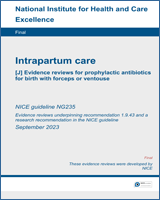From: Evidence reviews for prophylactic antibiotics for birth with forceps or ventouse

Evidence reviews for prophylactic antibiotics for birth with forceps or ventouse: Intrapartum care: Evidence review J.
NICE Guideline, No. 235.
London: National Institute for Health and Care Excellence (NICE); 2023 Sep.
Copyright © NICE 2023.
NCBI Bookshelf. A service of the National Library of Medicine, National Institutes of Health.